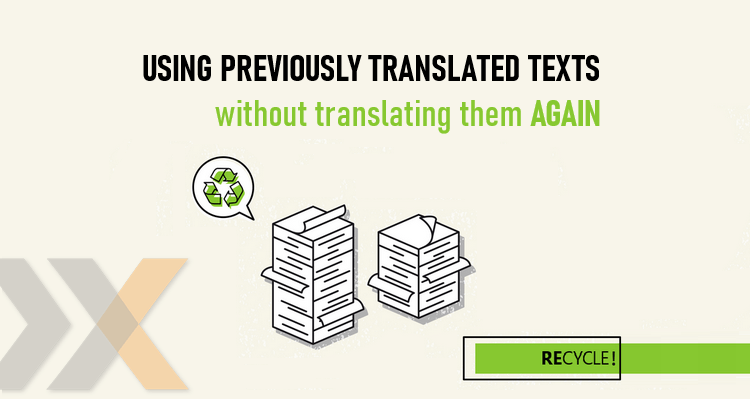Future proof your translations: Recycle them
Denisa Kytová 20.01.2020
For Customers
Reading time: 2 min.
20.01.2020
For Customers
Reading time: 2 min.

A company’s technical documentation almost always uses the same terminology, style and sentence structure. So every document can serve as a reference for the next one. If you’re having technical, legal or financial documents translated (especially longer ones), don’t throw the translations away. They’re recyclable!
How can previous translations help you with translating new texts?
Imagine you had a 100-page document you had translated several years ago. Back then, not many translation agencies used translation software, so you only have the translation in MS Word format. Now you need a new, 200-page document translated. Surely you’ll agree that searching for similarities in these documents would take forever. Who’s got that much time?
Luckily, this can be done thanks to a translation tools feature that makes translation more efficient. Previous documents and their translations can be paired using translation software (CAT tools). This feature is called Alignment and it can help you save time and money.
How does Alignment work?
If the original and the translation are correctly formatted, we can simply import them to a CAT tool that connects parts of the translation with the original. Normally, the text is paired by sentences. If the texts are incorrectly formatted, some parts must be edited manually. However it’s still shorter to match the source text to the translation than translating it from scratch. Based on the paired up document, we will create your own translation memory.
What are the advantages?
- Creation of a translation memory. If you use translation services more than once, you’ll surely appreciate having a translation memory for every subsequent translation. It’s especially useful when it comes to documents that are regularly updated or only partially modified.
- Maintaining translation terminology and style. It wouldn’t be easy for a translator to go through previous translations manually to find out what has already been translated, or when and how. After pairing previous translations with originals in a CAT tool and creating a translation memory, the translator will be able to search the previous translation quickly and easily. It can then be reused in the new translation to maintain the previous translation’s consistency and style.
- Less time to translate. Working with the previous translation means spending less time translating the new document.
- Minimizing the cost of translation. If you have texts translated again, ignoring similar translations that already exist, you’ll have to pay for the whole translation. Using the Alignment feature, we might find that the 200-page document contains only 120 pages of new text that need to be translated, while the rest can be “recycled”.
And finally our advice: If you’re translating company documentation that has been translated before, search for these previous translations and send them together with the new texts to your language service provider. It would be a pity to throw out translations that can be reused.
Do you need specialized translation of your company documents? Contact us at info@lexika-translations.com, we’ll gladly help you.

I started working at LEXIKA in 2017, shortly after getting a degree in translation and interpreting. I was overjoyed to be able to work in the field in which I majored. I work as a project manager and oversee the processing of projects, such as specialised (uncertified) translations, interpreting projects, and other related services. A pleasant and friendly atmosphere prevails in LEXIKA and while working, I learn a lot about the world of translation and interpreting, and it also helps me to grow as a person. (2020 Update: After more than two years, I decided to return to my home town, but I will always keep fond memories of LEXIKA and look forward to paying them a visit. I am happy and grateful that I could be part of the LEXIKA team.)
Share it!